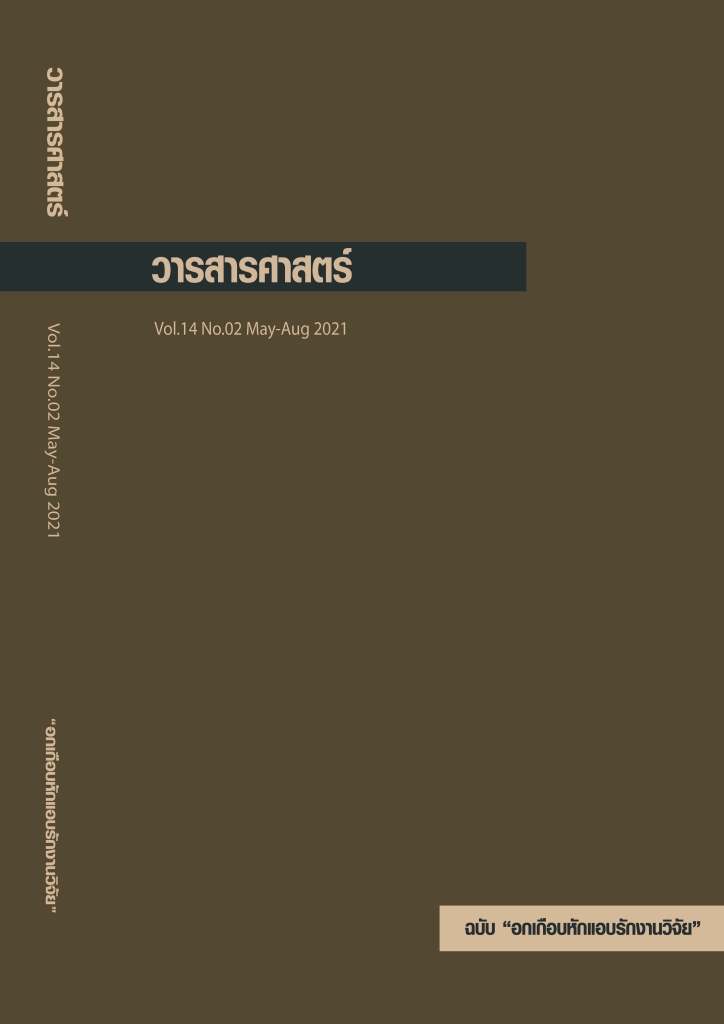การทดลองกับการวิจัยด้านโฆษณา: แนวคิด การประยุกต์ใช้ และความท้าทาย
คำสำคัญ:
การโฆษณา, การออกแบบการทดลอง, การวิจัยโฆษณาเชิงทดลอง, เทคโนโลยีการโฆษณาบทคัดย่อ
การพัฒนาด้านเทคโนโลยีการสื่อสารส่งผลให้การโฆษณาเปลี่ยนแปลง เกิดนวัตกรรมและเทคโนโลยีการโฆษณา เช่น การโฆษณาด้วยเทคโนโลยีปัญญา ประดิษฐ์ การโฆษณาด้วยเทคโนโลยีความจริงเสริม การโฆษณาด้วยเทคโนโลยี ความจริงเสมือน การโฆษณาผ่านแพลตฟอร์มออนไลน์และแอปพลิเคชัน เพื่อสื่อสารข้อมูลของสินค้า ตลอดจนสร้างความประทับใจ ความผูกพัน และ ประสบการณ์ระหว่างตราสินค้ากับผู้บริโภค ด้วยเหตุน้ีจึงทำให้นักวิจัยด้าน โฆษณาต้องใช้เครื่องมือการวิจัยให้สอดคล้องกับสถานการณ์การโฆษณาที่ปรับ เปลี่ยนไป และหนึ่งในเครื่องมือการวิจัยที่กำลังได้รับความนิยมในการประเมิน ผลการโฆษณารูปแบบใหม่ๆ คือ การทดลอง บทความนี้จึงมีวัตถุประสงค์เพื่อ นำเสนอการทบทวนแนวคิดเกี่ยวกับการทดลอง การประยุกต์ใช้การทดลองใน การวิจัยด้านโฆษณา การอภิปรายประเด็นความท้าทายและข้อจำกัดของการ ทดลองกับการวิจัยด้านโฆษณา เพื่อให้นักวิจัยด้านโฆษณาสามารถประยุกต์ใช้ การทดลองได้อย่างเหมาะสม
เอกสารอ้างอิง
เจนวิทย์ นวลแสง (2561), “จริยธรรมการวิจัยในมนุษย์ กับการวิจัยทางสังคมศาสตร์”, วารสารการเมือง การบริหาร และกฎหมาย, 10(2): 131-155.
ชาย โพธิสิตา (2550), ศาสตร์และศิลป์แห่งการวิจัยเชิงคุณภาพ, กรุงเทพฯ: สำนักพิมพ์แห่งจุฬาลงกรณ์มหาวิทยาลัย.
ธาดา สืบหลินวงศ์ และคณะ (2551), แนวทางจริยธรรมการทำวิจัยในคนในประเทศไทย พ.ศ. 2550, กรุงเทพฯ: ชมรมจริยธรรมการทำวิจัยในคนในประเทศไทย.
ธีรวุฒิ เอกะกุล (2543), ระเบียบวิธีวิจัยทางพฤติกรรมศาสตร์และสังคมศาสตร์, อุบลราชธานี: วิทยาออฟเซทการพิมพ์.
พิจาริน สุขกุล (2560), ผลของความสอดคล้องของการวางสินค้าในเกมและความเกี่ยวพันของสินค้าต่อการตอบสนองของผู้เล่นเกม, วิทยานิพนธ์ปริญญานิเทศศาสตรมหาบัณฑิต จุฬาลงกรณ์มหาวิทยาลัย.
พิมพ์พิไล ไทพิทักษ์ (2551), ผลของบริบทรายการโทรทัศน์ต่อประสิทธิผลของโฆษณา, วิทยานิพนธ์ปริญญานิเทศศาสตรมหาบัณฑิต จุฬาลงกรณ์มหาวิทยาลัย.
วรรณรดา สันทัดกลการ (2555), ผลของประเภทความสวยงามของนางแบบในโฆษณาและประเภทสินค้าต่อการตอบสนองของผู้บริโภค, วิทยานิพนธ์ปริญญานิเทศศาสตรมหาบัณฑิต จุฬาลงกรณ์มหาวิทยาลัย.
Ahmed, W. et al. (2016), “Does Advertising Exposure Level Matter? Implications for Experimental Research in Advertising, Business & Economic Review, 8(2): 23-32.
Babbie, E. (2008), The Basics of Social Research, Belmont: Thomson Wadsworth.
Baxter, L. and Babbie, E. (2004), The Basics of Communication Research, Belmont: Wadsworth Thomson Learning.
Bockelman, P. and Lingum, D. (2017), “Factors of Cybersickness”, in Stephanidis, C. (ed), 19th International Conference on Human-Computer Interaction, Springer: Cham.
Caballero, M. and Solomon, P. (1984), “Effects of Model Attractiveness on Sales Response”, Journal of Advertising, 13(1): 17-23.
Chang, C. (2017), “Methodological Issues in Advertising Research: Current Status, Shifts, and Trends”, Journal of Advertising, 36(1): 2-20.
Cheung, M. (2011), “Creativity in Advertising Design Education: An Experimental Study”, Instructional Science, 39(1): 843-864.
Cuesta, U. et al. (2018), “A Case Study in Neuromarketing: Analysis of the Influence of Music on Advertising Effectiveness through Eye-tracking, Facial Emotion and GSR”, European Journal of Social Science Education and Research, 5(2): 84-92.
De Gauquier, L. et al. (2019), “Leveraging Advertising to a Higher Dimension: Experimental Research on the Impact of Virtual Reality on Brand Personality Impressions”, Virtual Reality, 23: 235-253.
De Ruyter, K. et al. (2020), “Seeing with the Customer’s Eye: Exploring the Challenges and Opportunities of AR Advertising”, Journal of Advertising, 49(2): 109-124.
Eighmey, J. and Sar, S. (2007), “Harlow Gale and the Origins of the Psychology of Advertising”, Journal of Advertising, 36(4): 147-158.
Elder, R. and Krishna, A. (2010), “The Effects of Advertising Copy on Sensory Thoughts and Perceived Taste”, Journal of Consumer Research, 36: 748-757.
Geuens, M. and De Pelsmacker, P. (2017), “Planning and Conducting Experimental Advertising Research and Questionnaire Design”, Journal of Advertising, 46(1): 83-100.
Gidlof, K. et al. (2012), “The Use of Eye-tracking and Retrospective Interviews to Study Teenagers’ Exposure to Online Advertising”, Visual Communication, 11(3): 329-345.
Greco, A. and Swayne, L. (1992), “Sales Response of Elderly Consumers to Point-of-purchase Advertising”, Journal of Advertising Research, 32(5): 43-53.
Guna, J. et al. (2020), “Virtual Reality Sickness and Challenges behind Different Technology and Content Settings”, Mobile Networks and Applications, 25: 1436-1445.
Gunter, B. (2002), “The Quantitative Research Process”, in Jensen, K. (eds.), A Hand-book of Media and Communication Research: Qualitative and Quantitative Methodologies, London: Routledge.
Kerrebroeck, H. et al. (2017), “When Brands Come to Life: Experimental Research on the Vividness Effect of Virtual Reality in Transformational Marketing Communications”, Virtual Reality, 21: 177-191.
Kim, K. et al. (2014), “Trends in Advertising Research: A Longitudinal Analysis of Leading Advertising, Marketing, and Communication Journals, 1980 to 2010”, Journal of Advertising, 43(3): 296-316.
Lee, Y. et al. (2020), “Consumer Response to Virtual CSR Experiences”, Journal of Current Issues & Research in Advertising, 41.
McQuarrie, E. and Mick, D. (1999), “Visual Rhetoric in Advertising: Text-interpretive,Experimental, and Reader-response Analyses”, Journal of Consumer Research, 26(1): 37-54.
Neuman, W. (2006), Social Research Methods: Qualitative and Quantitative Approaches, New York: Pearson Education.
Nordhielm, C. (2020), “The Influence of Level of Processing on Advertising Repetition Effects”, Journal of Consumer Research, 29(3): 371-382.
Patel, J. et al. (2017), “Consumers’ Responses to Cause Related Marketing: Moderating Influence of Cause Involvement and Skepticism on Attitude and Purchase Intention”, International Review on Public and Nonprofit Marketing, 14: 1-18.
Perdue, B. and Summers, J. (1986), “Checking the Success of Manipulations in Marketing Experiments”, Journal of Marketing Research, 23(4): 317-326.
Popova, L. et al. (2014), “Testing Messages to Reduce Smokers’ Openness to Using Novel Smokeless Tobacco Products”, Tobacco Control, 23(4): 313-321.
Rebenitsch, L. and Owen, C. (2020), “Estimating Cybersickness from Virtual Reality Applications”, Virtual Reality, 24.
Royne, M. (2008), “Cautions and Concerns in Experimental Research on the Consumer Interest”, The Journal of Consumer Affairs, 42(3): 478-483.
Sekaran, U. and Bougie, R. (2010), Research Methods for Business: A Skill-building Approach, Chichester: Wiley.
Singh, T. et al. (2012), “Impact of Persuasive Communication on Product Awareness and Purchase Intention: A Quasi-experimental Study of Probiotic Products”, PRIMA: Practices and Research in Marketing, 3(1): 28-42.
Sinsuwarn, N. and Rattanakasamsuk, K. (2020), “Tobacco Packaging as Communication Tool:The Effectiveness of Tobacco Plain Packaging on Young People’s Perception”, Journal of Humanities and Social Sciences, Burapha University, 28(1): 98-119.
Vargas, P. et al. (2017), “A Practical Guide to Experimental Advertising Research”, Journal of Advertising, 46(1): 101-114.
Williams, K. (2011), “Improving Fear Appeal Ethics”, Journal of Academic and Business Ethics, 5.
Wilson, R., Baack, D., and Till, B. (2015). Creativity, attention and the memory for brands:an outdoor advertising field study. International Journal of Advertising, 34(2), 232-261. http://doi.org/10.1080/02650487.2014.996117.
Wimmer, R. D., and Dominick, J. R. (2006). Mass Media Research: An Introduction. Belmont: Thomson Wadsworth.
Yang, Y. (2017). Computational advertising: a paradigm shift for advertising and marketing?.IEEE Intelligent Systems, 32(3), 3-6. https://doi.org/10.1109/mis.2017.58.
Yim, M., Cicchirillo, V., and Drumwright, M. (2012). The impact of stereoscopic three-dimensional (3-D) advertising. Journal of Advertising, 41(2), 113-128. https://doi.org/10.2753/JOA0091-3367410208.








